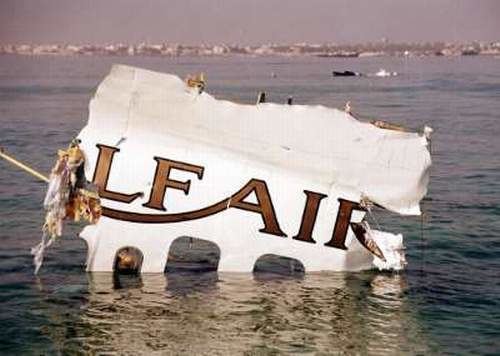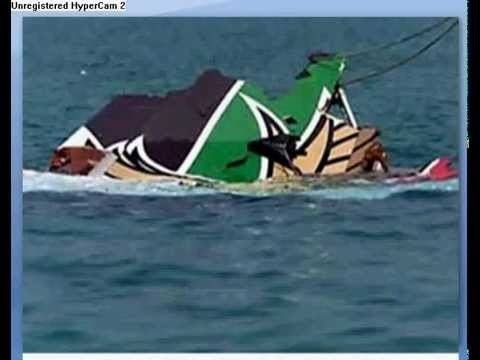Aircraft type Airbus A320-212 Date 23 August 2000 Total fatalities 143 (all) Crew count 8 | Passengers 135 Registration A4O-EK Passenger count 135 | |
 | ||
Similar Kenya Airways Flight 431, Air Philippines Flight 541, Gulf Air Flight 771, Alliance Air Flight 7412, Hapag‑Lloyd Flight 3378 | ||
Gulf Air Flight 072 (GF072/GFA072) was a scheduled international passenger flight from Cairo International Airport in Egypt to Bahrain International Airport in Bahrain, operated by Gulf Air. On 23 August 2000 at 19:30 Arabia Standard Time (UTC+3), the Airbus A320 serving the flight crashed minutes after executing a go-around upon failed attempt to land on Runway 12. The flight crew suffered from spatial disorientation during the go-around and crashed into the shallow waters of the Persian Gulf 5 km (3.1 mi) from the airport. All 143 on board the aircraft were killed.
Contents

The crash of Flight 072 remains the deadliest aviation accident in Bahraini territory and was the deadliest accident involving an Airbus A320 at the time, which was later surpassed by TAM Airlines Flight 3054, which crashed on 17 July 2007 with 199 fatalities.

The final report issued in 15 August 2002, concluded that the individual factors contributed to the accident was non adherence to a number of SOPs and loss of spatial and situational awareness by the aircraft crew during the approach and final phases of the flight. A number of systemic factors were also contributed to the accident, including deficiency in crew resource management training by Gulf Air and safety oversight by Directorate General Of Civil Aviation and Meteorology of Oman.

Aircraft

Flight 073 was operated with a Airbus A320-212, serial number 481, registration A4O-EK. It was first flown on 16 May 1994, and was delivered new to Gulf Air on September 1994. The aircraft was powered by two CFM International CFM56-5A3 engines. It had accumulated more than 17,000 hours in 14,000 cycles before the crash. Its last maintenance was conducted on 17–18 August 2000. The aircraft was in compliance with all applicable airworthiness directives for the airframe and engines.
Passengers and crew

The aircraft was carrying 143 passengers, two pilots, and six cabin crew members from 17 countries, mostly from Egypt and Bahrain. One Egyptian was supposed to board the flight but did not because the immigration officials in Cairo found that his passport was not stamped with the necessary interior ministry permit for working abroad.
Crew
There were two pilots in the aircrew:

Passengers
Among the 135 passengers were 61 men, 37 women and 37 children (including eight infants). An additional set of remains was found to be a fetus that had been delivered during the impact, but this was not counted as a fatality in the final report.
Notable passengers
Accident
The A320 with 143 passengers and crew on board approached the landing at higher speeds than normal and carried out an unusual low altitude orbit in an attempt to correct the approach. The orbit was unsuccessful and a go around was attempted. While carrying out a turning climb, the aircraft entered a descent at 15 degrees nose down. The aircrew did not respond to repeated GPWS warnings and approximately one minute after starting the go-around the aircraft disappeared from radar screens. There were no survivors. There were 36 children on the aircraft. The accident investigation concluded that the primary cause of the crash was pilot error (including spatial disorientation), with a secondary factor being systemic organizational and oversight issues.
After the accident Hamad bin Issa al-Khalifa, the Emir of Bahrain, declared three days of national mourning.
Investigation
The investigation showed that no single factor was responsible for the accident to GF-072. The accident was the result of a fatal combination of many contributory factors, both at the individual and systemic levels.
- The individual factors particularly during the approach and final phases of the flight were:
- The captain did not adhere to a number of SOPs, such as:
- significantly higher than standard aircraft speeds during the descent and the first approach
- not stabilising the approach on the correct approach path; performing an orbit, a non-standard maneuver, close to the runway at low altitude
- not performing the correct go-around procedure
- other related items
- In spite of a number of deviations from the standard flight parameters and profile, the first officer (PNF) did not call them out, or draw the attention of the captain to them, as required by SOPs.
- A perceptual study indicated that during the go-around after the orbit, it appears that the flight crew experienced spatial disorientation, which could have caused the captain to perceive (falsely) that the aircraft was ‘pitching up’. He responded by making a ‘nose-down’ input, and as a result, the aircraft descended and flew into the shallow sea.
- Neither the captain nor the first officer perceived, or effectively responded to, the threat of increasing proximity to the ground, in spite of repeated hard GPWS warnings.
- The captain did not adhere to a number of SOPs, such as:
- The systemic factors, identified at the time of the above accident, which could have led to the above individual factors, were:
- Organisational factors (Gulf Air):
- A lack of training in CRM contributing to the flight crew not performing as an effective team in operating the aircraft.
- Inadequacy in the airline's A320 training programmes, such as: adherence to SOPs, CFIT, and GPWS responses.
- The airline's flight data analysis system was not functioning satisfactorily, and the flight safety department had a number of deficiencies.
- Cases of non-compliance, and inadequate or slow responses in taking corrective actions to rectify them, on the part of the airline in some critical regulatory areas, were identified during three years preceding the accident.
- Safety oversight factors:
- Organisational factors (Gulf Air):
A review of about three years preceding the accident indicated that despite intensive efforts, the DGCAM as a regulatory authority could not make the operator comply with some critical regulatory requirements.
The chairperson of the accident investigation board adopted the report on 10 July 2002.
Aftermath
Gulf Air retired the Flight 072 (GF072) flight number and replaced it with Flight 070 (GF070) for inbound flights from Cairo to Bahrain.
